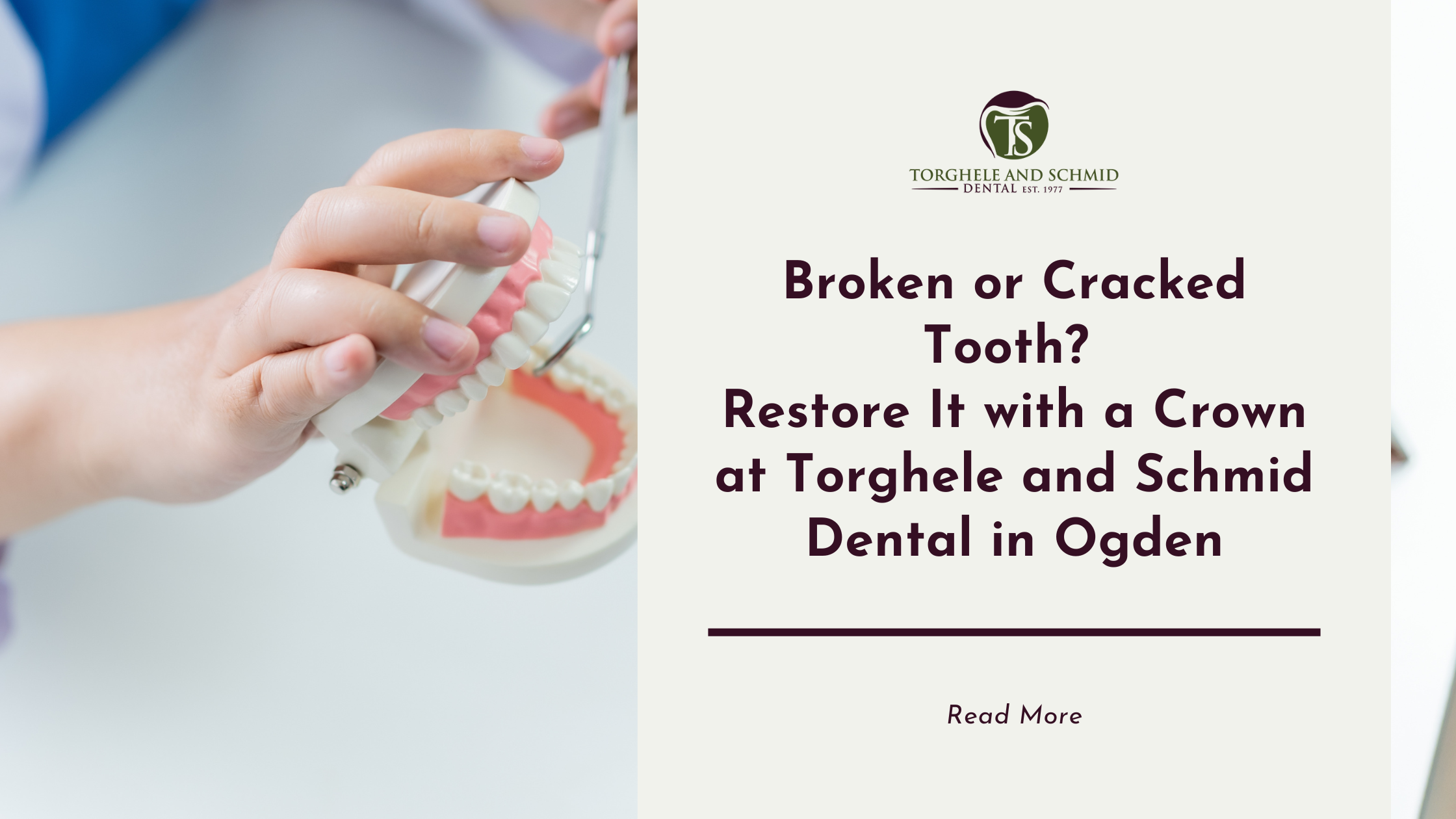BROKEN OR CRACKED TOOTH?
RESTORE IT WITH A CROWN AT
TORGHELE AND SCHMID DENTAL IN OGDEN

- A cracked or broken tooth can lead to pain, infection, and structural damage without timely intervention, making professional evaluation essential.
- Dental crowns restore strength, function, and appearance by covering damaged teeth completely, preventing further cracks and supporting long-term oral health.
- Torghele and Schmid Dental in Ogden offers careful planning, clear communication, and individualized treatment to help patients achieve lasting, confident smiles.
A cracked or broken tooth carries more than cosmetic consequences. It can lead to pain with every bite, a risk of infection, and long-term structural damage to your mouth. The fracture may spread, the nerve may become inflamed, or the tooth may weaken further until restoration becomes far more complicated.
Many people don’t realize how common these injuries are or how varied their causes can be. Biting down on a hard kernel, an accidental fall, a sports collision, teeth grinding through the night, or even an old filling giving way under pressure can all leave teeth vulnerable to cracking or breaking.
Fortunately, dentistry has highly refined ways of addressing these issues. Among the most reliable solutions is the dental crown: a time-tested treatment that protects, strengthens, and restores both function and appearance. At Torghele and Schmid Dental in Ogden, crowns are a cornerstone of comprehensive care, designed with precision and artistry to suit each patient’s needs.
Let’s look at what happens when a tooth breaks or cracks, what a crown actually does, and how this local practice helps people in Ogden regain confidence and comfort in their smiles.
Understanding Tooth Damage Beyond the Surface
A cracked or broken tooth is more than a visible flaw. It is a sign that the tooth’s protective enamel has failed in some way, allowing bacteria or pressure to affect the softer structures inside. A small chip may seem minor, but even hairline fractures can deepen over time. Left untreated, these cracks can compromise the integrity of the entire tooth, leading to infection of the pulp (the living tissue inside) or even complete loss.
The pain people feel with a cracked tooth is often due to pressure on these tiny fractures. When chewing or biting down, the crack flexes, irritating the nerve. Cold drinks or sugary foods may cause sharp sensitivity as they reach areas that should be sealed off. Sometimes, the crack itself serves as a hidden channel for bacteria, setting the stage for infection and abscess formation.
Restoring a cracked or broken tooth is about much more than filling the gap or smoothing the edges. It’s about protecting the living structures inside, sealing off pathways for bacteria, and restoring the tooth’s ability to absorb the forces of chewing safely.
Why a Crown is Often the Best Answer
Many damaged teeth can’t simply be filled. When a fracture runs deep enough, the tooth’s walls lose the strength to hold up under normal forces. A filling alone may act like a wedge, increasing the risk of splitting. Crowns are designed to prevent this scenario.
A dental crown covers the entire visible surface of the tooth like a custom-designed cap. It restores the tooth’s original shape, size, and function while providing a new protective layer. The crown essentially holds the tooth together, preventing cracks from spreading and shielding the inner structures from bacteria and stress.
For teeth that have large fillings already, crowns offer a solution when the remaining natural structure is too weak to hold another filling securely. After root canal treatment, crowns are often recommended because the procedure removes the nerve and blood supply, making the tooth more brittle over time. A crown reinforces it, reducing the chance of fracture.
The decision to place a crown isn’t about cosmetic perfection alone. It’s about the tooth’s long-term survival in the mouth. Crowns extend the life of damaged teeth, preserve your bite alignment, and help you chew comfortably.
Types of Tooth Damage That May Need a Crown
A wide range of injuries and conditions can lead to needing a crown. These include:
- Cracked Tooth Syndrome: A tooth with a hairline fracture that causes pain on chewing but may be hard to see on X-rays. Without a crown, the crack can deepen and split the tooth.
- Large Chips or Breaks: A major portion of the tooth is lost, leaving it too weak to restore with bonding or a filling alone.
- Teeth with Extensive Fillings: When the natural tooth structure is minimal, it cannot support another filling securely. A crown offers full coverage.
- Root Canal–Treated Teeth: After a root canal, the tooth loses some moisture and flexibility. A crown prevents fracture and restores strength.
- Severe Wear from Grinding (Bruxism): Long-term grinding can flatten and weaken teeth, making crowns necessary to rebuild proper form and function.
The key is early evaluation. A crack or chip that feels minor can develop into a serious issue if ignored. By seeking professional assessment, you can often avoid pain, infection, and extraction.
How Crowns Are Made and Placed at Torghele and Schmid Dental
Restoring a tooth with a crown is a blend of clinical science and artistry. At Torghele and Schmid Dental, the process is carefully tailored to the individual patient, ensuring a comfortable experience and a precise, natural-looking result.
The typical crown procedure involves:
- Initial Examination and Planning: The dentist assesses the damage using a visual exam, X-rays, and, if needed, other diagnostic tools. They consider how much healthy structure remains and which type of crown suits the tooth’s position and function best.
- Tooth Preparation: Damaged or decayed portions are removed, and the tooth is carefully shaped to hold the crown securely. This step requires precision to balance strength, fit, and preservation of as much natural tooth as possible.
- Impression or Scan: A highly accurate mold or digital scan is taken of the prepared tooth and surrounding bite. This ensures the crown will match precisely in shape, size, and alignment.
- Temporary Crown: While the final crown is fabricated, a temporary crown protects the tooth and maintains function.
- Final Placement: When the custom crown is ready, the dentist checks the fit and color match, makes any necessary adjustments, and bonds it securely with dental cement. The result feels like a natural tooth and is designed to last for years with proper care.
Crowns may be made from various materials, including porcelain, zirconia, metal alloys, or combinations. Each has advantages depending on location in the mouth, desired appearance, and patient preferences. The team here takes the time to explain these options, helping patients make informed choices that match their goals.
Comfort and Quality at Every Step
One reason many Ogden residents choose us is the attention to detail and patient experience throughout this process. Dental visits can be stressful, especially when dealing with a broken tooth that already hurts. The team focuses on clear communication, gentle techniques, and creating a welcoming environment where people feel heard and respected.
Patients are walked through the entire plan, with questions answered openly. Modern anesthetics and methods minimize discomfort. Temporary crowns are carefully fitted to avoid disrupting eating and speaking while waiting for the final crown. Follow-up care ensures the crown functions properly and remains comfortable in the bite.
Restoring a tooth with a crown requires precision at every stage. This level of commitment can mean the difference between a restoration that fails prematurely and one that serves reliably for many years.

Beyond Repair: Preventing Further Damage
While crowns are excellent at restoring compromised teeth, prevention remains essential. Our team emphasizes helping patients understand how to reduce future risk.
For many, grinding or clenching at night is a hidden culprit. A custom night guard can help absorb forces that might otherwise crack teeth or damage crowns. Addressing bite alignment issues or replacing missing teeth can also reduce abnormal pressure on existing teeth. Regular checkups allow small problems to be caught before they escalate, avoiding the need for more extensive treatment.
Even daily habits make a difference. Chewing on ice, opening packages with teeth, or consuming excessively acidic drinks can all weaken enamel. Patient education is a key part of the practice’s philosophy, empowering people to maintain their restorations and natural teeth as long as possible.
The Emotional Side of Restoring Your Smile
A cracked or broken tooth not only affects function. It can create self-consciousness, embarrassment, and even avoidance of social situations. Many people instinctively cover their mouths when they speak or laugh. They may avoid certain foods or chew only on one side, constantly aware of the vulnerable area.
Restoring a tooth with a crown is about reclaiming confidence. The ability to speak clearly, chew comfortably, and smile without worry has a deep impact on quality of life. A well-designed crown blends with surrounding teeth, restoring a seamless appearance. For many patients, it’s an emotional relief to feel whole again, without that daily reminder of damage or fragility.
At Torghele and Schmid Dental, this personal side of care is never overlooked. Dentistry is more than a clinical service—it’s a partnership in helping people feel their best.
How Long Does a Crown Last?
A common question is how durable a crown will be. While lifespan varies based on material, oral hygiene, and biting forces, well-made crowns often last 10–15 years or longer. With regular professional care and good daily habits, many patients keep their crowns far beyond that range.
Routine checkups are vital. Dentists monitor the integrity of the crown, the health of surrounding gums, and the underlying tooth structure. Addressing small issues early can extend the crown’s life significantly.
Patients can also help by maintaining excellent brushing and flossing habits, avoiding harmful habits like chewing ice, and wearing recommended night guards. Crowns themselves cannot decay, but the tooth underneath can if bacteria infiltrate the margin where the crown meets the tooth. Meticulous hygiene remains important to protect the investment in your health.
Personalized Care in Ogden
What sets us apart is a commitment to personal connection and clinical excellence. Restoring a broken or cracked tooth is a highly individualized process. Each case is evaluated on its own merits, with treatment plans tailored to the patient’s unique needs, lifestyle, and goals.
The team believes in transparency and education, explaining the reasoning behind recommendations and helping patients feel empowered in their decisions. Rather than rushing through procedures, they take time to ensure fit, comfort, and aesthetics all align. This philosophy builds trust and encourages lasting relationships with the community.
For many in Ogden, that sense of partnership is as important as the clinical results themselves. Dentistry isn’t about providing a single fix and sending someone on their way. It’s about supporting lifelong oral health, one well-considered restoration at a time.

MEET OUR OGDEN DENTAL TEAM!
Torghele Dentistry is a family-owned dental office conveniently located in Ogden, UT. We offer a broad range of dental services, from top-notch preventive care to advanced dental implants. Come see why we've been such an important part of the community for the past four decades!
SCHEDULE YOUR
VISIT NOW!
MAP
WHY CHOOSE US
- Same-Day Emergency Appointments
- Life-Changing Dental Implants
- Sedation Options for Nervous Patients
- No Insurance? No Problem!
- Special Offers for New Patients






